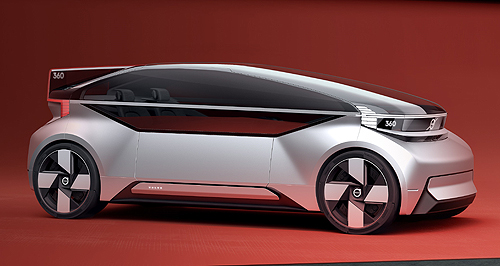Make / Model Search
News - Volvo - 360cVolvo looks to future with driverless 360cSick of airports? Volvo says autonomous 360c is the alternative for intercity travel6 Sep 2018 VOLVO wants to take on the airline industry with autonomous cars that can whisk passengers between cities by road overnight while they work, relax or sleep in business-class-style lay-flat seats, protected by special safety blankets.
The Swedish company also called for new global standards for fully autonomous car communication with other road users by a system of lights, colours, sounds and movements to replace today’s subtle human road-user interaction by eye contact, head turn and hand gestures.
Volvo says such protocols are crucial for the safe operation of autonomous cars, especially in the introduction phase when such vehicles will be mingling in traffic with conventional cars and trucks.
The company made these points when unveiling arguably the most advanced autonomous car concept to date, the all-electric 360c, in Sweden overnight.
While the four-seat car with its huge walk-in door might never be built in its current format, the technologies and design features might well make it into future cars.
The small but spacious pod-like car is designed for multiple purposes such as commuter transport, mobile office, entertainment space and – on long-haul trips – sleeping quarters.
One of the major features of the car is Volvo’s attempt to provide easy-to-understand signals to other road users, including drivers, pedestrians and cyclists, of the car’s intentions so that they do not get caught by surprise and end up a road accident statistic.
These include small finger-like lights that swing out from the indicators to accentuate the intention to turn in a particular direction and lights than can change colour to convey various moves.
Volvo – which was instrumental in the introduction of major safety advances such as seatbelts and autonomous emergency braking in today’s cars – wants the vehicle to trigger a global discussion among car-makers and road safety authorities with the ambition of deciding global standards for such protocols.
Volvo Cars chairman Hakan Samuelsson said autonomous cars were the future of mobility and safer road transport.
“It is important to Volvo that we should be in the lead and transforming our business,” he said.
Mr Samuelsson said autonomous vehicles’ ground-breaking technology would not only make roads safer but “allow people to spend hours in their car doing something else instead of sitting driving”.
Volvo says wasted time at airports is a hassle, with travellers ending up spending more time getting on the plane than on the plane in domestic flights.
In Volvo’s futuristic vision, a car like the 360c will collect a passenger from their home or office and transport them by road directly to their destination in another city by the next day while they sleep.
The company has even invented a new form of blanket that can protect the passenger while they are laying down, replacing the conventional seatbelt.
Volvo senior vice-president of product strategy Marten Levenstan said domestic air travel looked good when a person bought a ticket but ended up being “not really pleasant at all”.
He said domestic air travel was a multi-billion industry that was open to disruption by alternative forms of transport.
“It is a massive business opportunity to find an alternative to this,” he said. “The 360 concept is a way to start thinking about airlines. Suddenly a car can compete with domestic air travel.”
Mr Levenstan likened the 360c concept to the Wright brothers’ first plane, saying it represented a starting point in the development of autonomous travel rather than the finish point.
Volvo says one of the greatest challenges of fully autonomous vehicles was making sure other road users understood what the vehicle was about to do – turning, stopping, accelerating reversing and so on.
“Autonomous technology will be introduced gradually rather than overnight,” Volvo said in its press release. “As a result, fully autonomous cars will be introduced in a mixed traffic situation where driverless cars without a human driver will share the road with other road users.
“In such a traffic situation, it will no longer be possible to make eye contact with and learn about another driver’s intentions, a central element of today’s everyday traffic interaction.”
The Volvo 360c addresses this with external sounds, colours, visuals and movements, as well as combinations of these tools, to communicate the vehicle’s intentions to other road users.
Volvo Cars Safety Centre vice-president Malin Ekholm said this communication should be a universal standard so all road users could communicate with any autonomous car regardless of brand.
“But it is also important that we do not instruct others what to do next, in order to avoid potential confusion,” he said. “Our research shows this is the safest way for fully autonomous cars to communicate with other road users.”  Read more |
Click to shareVolvo articlesResearch Volvo Motor industry news |











Facebook Twitter Instagram